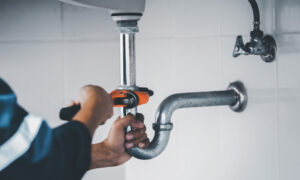Garbage disposals are a kitchen convenience for many. But have you ever wondered how these compact yet powerful devices actually work? After an installation by a professional plumber in Fredericksburg, VA, these devices can help keep your kitchen cleaner, reduce waste, and even shield your pipes from clogs.
Let’s discuss how garbage disposals work and what happens to your leftovers once they disappear down the drain.
The Basics of a Garbage Disposal
A garbage disposal is a plumbing device installed under kitchen sinks. Its primary purpose is to grind food waste into tiny particles. Once ground, food can easily flow through your plumbing without causing blockages.
Before we proceed, let’s dispel a common misconception here and now. A disposal’s blades aren’t actually blades. A combination of impellers and a grinding plate are what are referred to as ‘blades’. These crush food waste against the disposal’s shredding ring.
Why Do People Use Garbage Disposals?
A garbage disposal is a lifesaver for many. It speeds up cleanup after meals, eliminates the smell of rotting food in the trash, and keeps the plumbing system flowing smoothly.
Common reasons homeowners rely on garbage disposals:
- Less trash: Instead of dumping food waste in the garbage where it can attract pests or rot, you can grind it up and send it down the drain.
- Cleaner kitchen: Fewer food scraps mean fewer odors and less mess.
- Helps prevent clogged pipes: Disposals reduce the chance of food waste clogging up your drains.
How Does a Garbage Disposal Work?
Once you turn the disposal on, it springs into action and performs as follows:
- Switch it on: You flip the switch, and the electric motor in the disposal begins to spin the grinding plate at high speed.
- Impellers push food: The impellers inside the disposal push the food waste against the stationary shredder ring. As the food waste comes in contact with the ring’s jagged teeth, it’s ground into smaller and smaller pieces.
- Grinding the waste: There aren’t sharp blades in a garbage disposal, contrary to popular belief. Instead, it relies on the force of impellers and the grinding ring to crush food.
- Water flushes it down: Running cold water while using the disposal helps flush the ground-up particles down the drain, where they can safely pass through your plumbing system.
The Components of a Garbage Disposal
Garbage disposals are compact. Despite their tiny frame, they contain several parts that work together to keep your sink clear of food debris.
- Motor: The motor is the powerhouse of the disposal, rotating the grinding plate and impellers.
- Flywheel: This spins with the motor, driving the impellers that crush food waste against the shredder ring.
- Shredder Ring: Lined with jagged edges, this stationary component is where the grinding happens.
- Impellers: These aren’t sharp blades but rather blunt components that guide food waste against the shredder ring.
- Reset Button: If the disposal becomes overloaded or jammed, this button can restart the device after the issue is resolved.
- Drain Pipe: Once food is broken down, water helps carry it through your drain pipes into the plumbing system.
What Should You Put in Your Garbage Disposal?
Garbage disposals aren’t garbage cans that can handle everything. Treating your unit right, bolstered by maintenance from a plumbing company, will keep it running smoothly.
Safe to grind:
- Soft food scraps (fruit and vegetable peels)
- Coffee grounds
- Small bones
- Eggshells (in small quantities)
Avoid:
- Grease, oils, or fats (they can harden and block pipes)
- Large bones or shells
- Fibrous materials like celery or corn husks
- Starchy foods like rice or pasta, which can swell and clog your pipes
What If Your Disposal Stops Working?
Even the best-maintained disposals can run into problems. If you notice it’s not working correctly, there are a few things you can try before calling an expert for a plumbing repair:
- Reset the unit: If the disposal shuts off unexpectedly, try pressing the reset button on the bottom of the unit.
- Check for jams: Sometimes, food waste or a foreign object can cause a jam. Rotate the flywheel manually with an Allen wrench.
- Turn off the power: Always disconnect the power before attempting to troubleshoot or repair your disposal.
If none of these steps work, it might be time to bring in a professional to diagnose the issue.
Understanding the inner workings of a garbage disposal is invaluable. It gives you an idea of how to maintain it, as well as preventing frustrating breakdowns and costly repairs. Your disposal is an invaluable kitchen tool. Treating it with care, using it properly, and taking steps to clean it regularly will help extend its life.




































